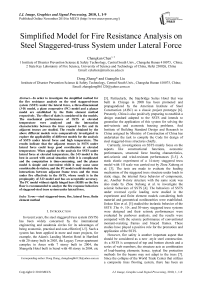Simplified Model for Fire Resistance Analysis on Steel Staggered-truss System under Lateral Force
Автор: Changkun Chen, Dong Zhang, Guanglin Liu
Журнал: International Journal of Image, Graphics and Signal Processing(IJIGSP) @ijigsp
Статья в выпуске: 1 vol.2, 2010 года.
Бесплатный доступ
In order to investigate the simplified method for the fire resistance analysis on the steel staggered-truss system (SSTS) under the lateral force, a three-dimensional (3-D) model, a plane cooperative (PC) model and a planar model are established by the finite element method respectively. The effect of slabs is considered in the models. The mechanical performances of SSTS at elevated temperature were analyzed and the interaction characteristics between the truss exposed to fire and its adjacent trusses are studied. The results obtained by the above different models were comparatively investigated to explore the applicability of different models for the analysis of SSTS under lateral force and high temperature. The results indicate that the adjacent trusses in SSTS under lateral force could keep good coordination at elevated temperature. When applied to the analysis for SSTS under lateral force at elevated temperature, the 3-D model is the best in accord with actual situation while it is complicated and the computation is time-consuming, and the planar model is simple and convenient while it may cause some considerable deviation, and the PC model could simulate the interactions between adjacent frame truss and the truss under fire effectively in the SSTS, whose result is in the propinquity of 3-D model and has an acceptable accuracy. The PC model without rigidly hinged bars (RHB) on the fire floor is recommended to analyze the fire response behaviors of staggered-steel truss system under lateral force.
Steel staggered-truss, fire, lateral force, finite element method
Короткий адрес: https://sciup.org/15012024
IDR: 15012024
Текст научной статьи Simplified Model for Fire Resistance Analysis on Steel Staggered-truss System under Lateral Force
Published Online November 2010 in MECS
-
I. Introduction
In recent years, the steel staggered truss system (SSTS) has been widely concerned by the international engineering and academia circles for its advantages of being economic, practical and cost-effective[1-5]. Such a system has been applied in more and more projects, for example, the Adam's Landing Marriot Hotel in Hartford with 20 storey built in 2003, the Legacy Tower apartment complex in Ames with 7 storey built in 2004, the Shangrila Hotel built in Seoul with 48 storey in 2004, etc
Corresponding author: Dong Zhang, zhangdong861120@yahoo.com.cn
-
[3] . Particularly, the Staybridge Suites Hotel that was built in Chicago in 2008 has been promoted and propagandized by the American Institute of Steel Construction (AISC) as a classic project prototype [6]. Presently, China is also positively preparing to establish a design standard adapted to the SSTS and intends to generalize the application of this system for solving the anti-seismic and economic housing problems. And Institute of Building Standard Design and Research in China assigned by Ministry of Construction of China has undertaken the task to compile the Code for design of steel staggered-truss structures chiefly.
-
Currently, investigations on SSTS mainly focus on the aspects like constructional functions, economic performances, structural force bearing characteristics, anti-seismic and wind-resistant performances [3-5]. A static elastic experiment of a 14-story staggered truss model with 1/8 scale was carried out by Zhou Xuhong et al. [3]. The tests are made to evaluate the loading mechanism of the staggered truss structure under loads in static stage, the internal force behavior of components, etc. Another 8-story structure with the same scale was also made by Zhou Xuhong et al. to investigate the seismic behaviors of SSTS [4]. The behaviors of SSTS under reversed cyclic loading were studied in the experiment and finite element models considering both material and geometrical nonlinearities were established. Jinkoo Kim et al. [5] studied the inelastic behavior of the SSTS .The 4-, 10-, and 30-story staggered truss systems were designed and their seismic performances were evaluated by pushover analysis, and the results were compared with the seismic performance of conventional moment-resisting frames and braced frames. These studies have played a positive role for the promotion and application of the SSTS.
However, fire safety is another important aspect that should be considered as a new -style steel construction. As a SSTS is composed of top and bottom chords and a series of web members, the structure acts as combination of load-bearing elements; hence, typical fire protection methods for the beams may not adapt to the truss [7]. Since the collapse of the World Trade Center that utilizes a composite truss flooring system, there has been an impetus to study the reaction-to-fire performance of the particular arrangement of composite truss systems [9-11]. However, there are few reports regarding the study of fire-resistant properties of the SSTS. The Steel Design Guide Series 14: Staggered Truss Framing System [12] launched by AISC (2002) is an international authoritative guiding document for the design of this system, but the part of its fire-resistant design is just an extension of general steel structures. It has not given the detailed design description based on the structural characteristics. Numerical simulations were conducted initially by Chen et al.[13,14] regarding the structural behaviors of a staggered-steel truss system under different vertical loads exposed to local fire, by using a plane six-floor model to simplify the structural pattern. A preliminary discussion was made of the variation of the axial force and the bending moment of staggered truss structural system under local fire conditions. However, as an efficient system of lateral force resistance, which is one of the most primary advantages on the popularization and application of the structure, the fire resistant property under lateral force, which has not been involved in the early studies, should also be paid more attention to understand the structural response behavior under lateral force in fire, and some simplified methods are expected to be obtained to improve the efficiency of the fire protection analysis and design for this new-style structure.
assumed that there is no relative displacement between each truss at the same story. The calculation scheme of
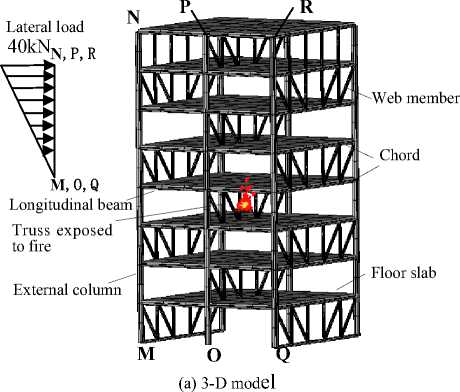
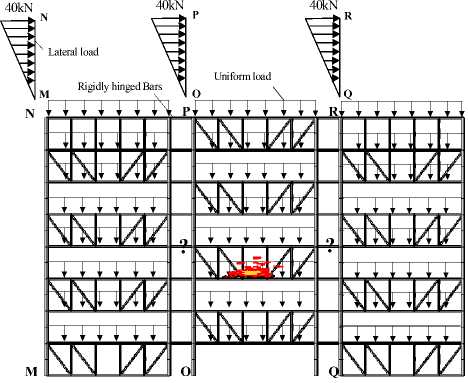
(b) Plane cooperative model
In this paper, three-dimensional (3-D) model, plane cooperative (PC) model and planar model are proposed to simulate the mechanical response of SSTS at elevated temperature using finite element method. The investigation focuses on the interaction characteristics between truss exposed to fire and the adjacent truss in the structure. And the high-temperature responses of the SSTS under lateral force such as axial force, bending moment and displacement are studied. According to a detailed comparative analysis among the results of different models, the applicability of different models for the analysis of SSTS under lateral force and high temperature are explored. Based on the analytical results, some suggestions are presented for the further research and fire-resistant design of staggered truss system.
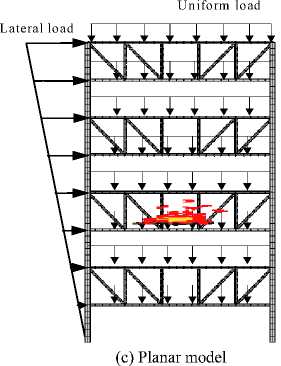
Figure 1.The schema of different models to the SSTS
-
II. Model descriptions and assumptions
3-D model, PC model and planar model for SSTS are established using finite element method as follows.
As shown in Fig.1 (a), the 3-D model of SSTS is an 8-story structure with a storey height of 3m for each storey. It is composed of 3 transverse frames connected by the concrete slabs and longitudinal beams. The space between two adjacent frames is 6m. Storey-high trusses are arranged alternately in each frame. There are 5 panels in each truss with 2.5 meter width for each panel. The truss span and total height of the model are 12.5 and 24.0 m, respectively.
As to the PC model, the spatial effect of the truss is simplified and the trusses are placed in a plane. The roles of floors are supposed to be simply replaced by the rigidly hinged bars (RHB) in the scheme to transfer horizontal shearing force [16]. In this model, it is the truss exposed to fire is selected to construct the model. The spatial effect of the truss is ignored and the effect of the PC model for SSTS is given in Fig.1 (b).
In planar model (See Fig.1 (c)), only the frame with high temperature to the SSTS is considered to be limited in the area of the truss exposed to fire.
This study aims to gain more insight into the general
Slab
Top chord HSS200×200×10
0.200m
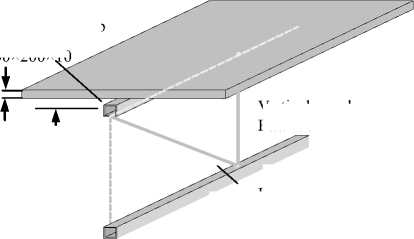
Height 2.5m
Diagonal member HSS160×160×10
Bottom chord
HSS200×200×10
(a) Numerical model of cross section longitudinal to composite truss
Vertical member HSS160×160×10
Pin connection
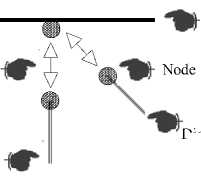
Diagonal web
-
(b) Detail of connection between top and bottom chords and web members
Figure 2. Details of section and connection of SSTS
TABLE I.
DETAILS OF MEMBERS USING IN THE MODELS
|
Members |
Cross section/mm |
|
External column |
HSS350×350×16 |
|
Chord |
HSS200×200×10 |
|
Web member |
HSS160×160×10 |
|
Longitudinal beam |
HSS200×200×10 |
TABLE II.
O verview of the study case
The details of members using in the models is tabulated in Tab.1. The material strength of steel is 235MPa. And the thickness of floor slab in 3-D model is 0.2m. For the stress-strain relationship of the steel, the ideal elastic-plastic model was used, and the strengthtemperature and stiffness-temperature models recommended by EC3 [15] were adopted. According to the EC3, the yield stress of the steel at different temperatures was defined by the value when the strain equal to 0.2%.The thermal expansion coefficient of steel is taken as 1.4×10-5 (oC-1) [17].
The floor slabs are connected to the beams by connectors. And all floor slabs are under a uniformly distributed load of 7kN/m2, which is 42kN/m of uniform load for the chords in PC model and planar mode. The left nodes of every frame are imposed with a force load which is distributed as an inverted triangle with a peak value of 40kN. It is considered that the fire is on the forth floor of the center frame of 3-D model with the top chords and web members exposed to fire, and the scene of the fire environment is in line with the ISO834.
To construct finite element analytical model by ANSYS software, the shell element SHELL181 is adopted to simulate the floor slabs; and the threedimensional beam element BEAM188 is introduced to simulate the columns, chords, longitudinal beams and web members. The connectors between the slabs and beams are simulated using COMBIN39.
Initial imperfections such as specimen initial crookedness and load eccentricity are all ignored during the analysis.
Ш. Study case
In order to explored the applicability of different models for the fire resistance analysis of SSTS under lateral load, different cases are explored as tabulated in Tab.2. As the slab may be destroyed by high temperature, two extreme situations are considered in 3-D models. The slabs at the fire floor are preserved, when there is enough stiffness in slabs to transfer the shear force at elevated temperature. On the other hand, the slabs at the storey in fire are deleted as an extreme case when the slab is failure at elevated temperature. Correspondingly, the RHB at the storey exposed to fire are preserved in the PC model when it is considered that the floor slabs are not destroyed, and they are deleted for simulating the situation that the slabs are failure.
To facilitate the analysis of the mechanical response under high temperature, the components of the truss exposed to fire are labeled as shown in Fig. 3.
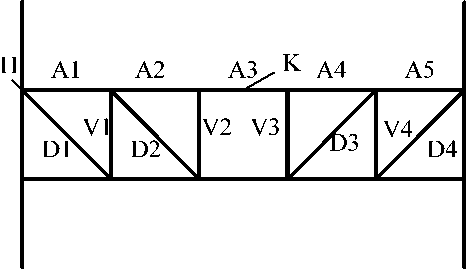
Figure 3. Labels of the components and cross section in
the truss exposed to fire
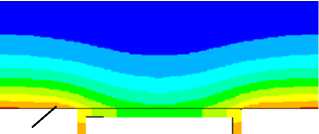
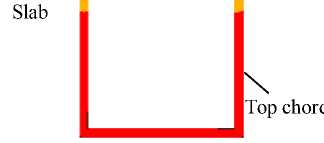
(a) Top chord

20.81
122.97
223.97
325.56
427.14
528.72
630.30
731.88
833.47
935.05
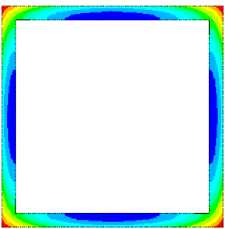
(b) Web member
Figure 4. Temperature contours of the member cross-section (Time: 60min)

935.29
935.44
935.60
935.76
935.91
936.07
936.22
936.38
936.54
936.69
W. Temperature assessments
The element PLANE55, a 4 node two-dimensional element, with which the effect of thermal convection and heat radiation could be considered well, was used in the thermal analysis for the cross-section of the unprotected steel truss with 0.2m concrete slab on the chord. The grid density for thermal analysis was 1mm for each element. And the calculation was performed by the software ANSYS.
For the concrete slab, the density, thermal conductivity and specific heat were taken as 2300kg/m3, 1.6W/mK and 1000J/kg K, respectively [17].
Fig.4 shows the temperature contours of the crosssection of the chord and the web member exposed to a standard fire for an hour. As can be seen in the figures, when the web is heated on four surfaces, the difference in temperature of the whole section is slight enough to be
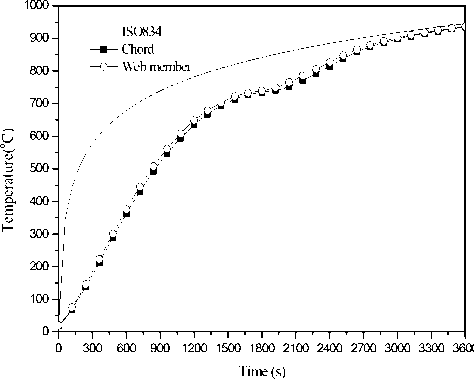
Figure 5. Temperature development of the heated chord and web members in staggered truss
negligible. And when the chord is heated except the top surface protected by the concrete slab from fire, the temperatures in the vast majority of the cross section are almost the same. However, gradient temperature within the chord cross-section result from the heat sink effect of the concrete slab on the top flange is also obvious. Special references on the study of the temperature gradient effect within the beam cross-section on the structural behaviors were made by Yin and Wang and Santiago et al. [18,19], which indicate that the temperature gradient has a small influence on the structural behaviors at high temperatures, and the temperature of bottom flange can be used on the structural analysis. Therefore, in this paper, the temperature gradient in the cross-section has not been taken into account for convenient analysis, and the temperature of the bottom flange of the heated chord cross-section was used for structural analysis.
Fig.5 shows the temperature curves of the chord and web member during 60 min for the unprotected steel exposed to an ISO834 Standard Fire.
-
V. Structural response analysis
According to the finite element analysis for 3-D model, it is found that the SSTS has developed a large lateral deformation under lateral force through the fire duration. The lateral displacement curves of each frame at different temperature in 3-D Model A are depicted in Fig.6. As can be seen, the adjacent trusses still have a good coordination at elevated temperature, and the relative displacement of the adjacent trusses is very slight at the storey which is not exposed to fire. Because of the large stiffness of the slabs, the trusses in different planes are connected into a whole and the adjacent trusses resist the lateral deformation together. At the storey under fire exposure, the high temperature makes a great influence on the lateral deformation of the truss exposed to fire. But the high temperature has a little impact on the adjacent trusses. According to the above analysis, PC model and planar model can be used to the high temperature response analysis on SSTS under lateral force.
bending moment near the storey under fire exposure has a notable high peak at elevated temperature. But there is
s
X
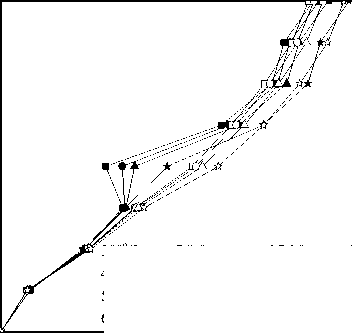
300oC PO frame NM frame and RQ frame 400oC PO frame NM frame and RQ frame 500oC PO frame NM frame and RQ frame 600oC PO frame NM frame and RQ frame
0 5 10 15 20 25 30 35 40 45 50
Lateral displacement (mm)
Figure 6. Lateral displacement curves of each frame of truss at different temperature in 3-D Model A
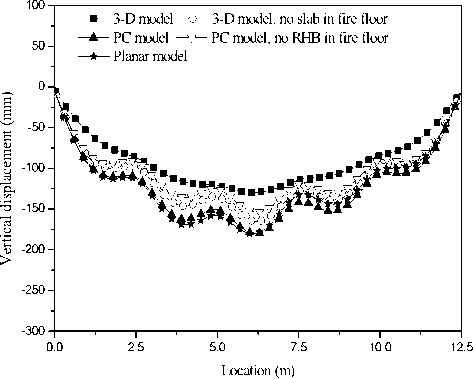
Figure 8. Vertical displacements of the top chord exposed to fire at 600oC
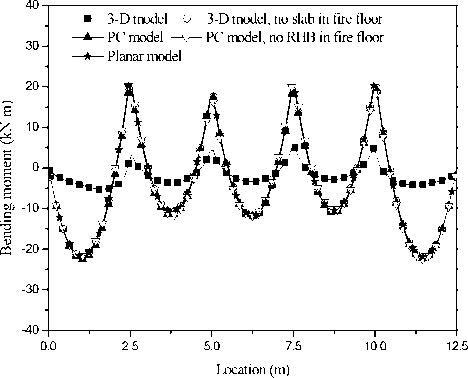
Figure 7. Bending moments of top chord at the fire floor in each case at 600oC
The bending moments of top chord at the fire floor in each case at 600° C are shown in Fig.7. In 3-D Model A, the bending moment peaks along the chord are small and distributing equably. But in the 3-D Model B, the internal force of SSTS redistributes because of the effect of high temperature. A large bending moment emerges at the bilateral panels of the top chord (A1 and A5). The similar phenomenon appears in the two PC models and planar model.
The vertical displacements of the top chord exposed to fire at 600oC are given graphically in Fig.8. As can be seen, the vertical displacement of top chord in 3-D Model A is smaller than the displacement in other cases because of the effect of the slabs. In 3-D Model B, when the failure of slabs is considered, the vertical displacement of top chord exposed to fire has a certain extent increase. Its curve of vertical displacement is similar to the one obtained by PC model without RHB in fire floor.
Fig.9 plots the bending moment of left external column of the frame exposed to fire. It can be seen that the
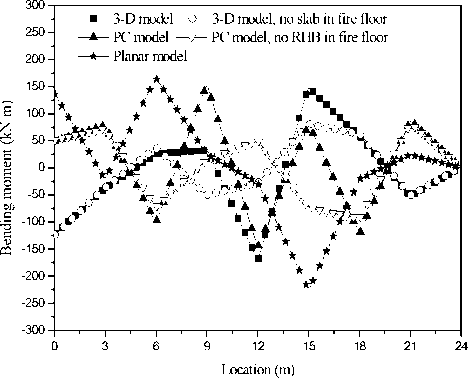
Figure 9. Bending moment of left external column of the truss exposed to fire at 600oC obvious difference between the bending moments obtained by different models. That is because the restrictions of the truss exposed to fire are different according to different simplification. In 3-D models, the bending moment near the fire floor presents distinct changes when the failure of slabs is considered, making it be different with the cases which the slabs are not destroyed. While, in both two cases for PC models, the adjacent frames in both sides restrict the lateral deformation of the truss under fire distinctly, making a great redistribution of internal force in the truss. As a result, the bending moment of left external column of the frame exposed to fire varies near the storey in fire. Because the restriction of slabs to the external column is neglected in planar model, the peaks of bending moment in this case are relatively large. Thus, it can be concluded that the constraint of slabs would make some observable influence on the analysis of lateral performance to the SSTS at elevated temperature.
The lateral displacement of left external column of the frame in fire in different cases at 600oC is illustrated in
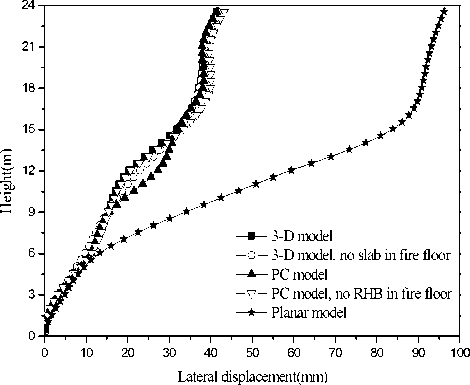
Figure 10. Lateral displacement of left external column of the truss exposed to fire at 600oC.
(A2, A3 and A4). And the compressive force in the chord starts to be relieved gradually. The vertical displacement
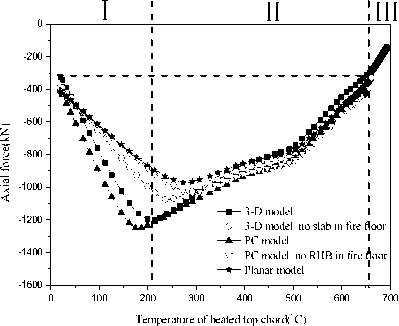
Fig.10. As shown in the figure, the lateral displacement at the top floor obtained by 3-D model and PC model are all about 44mm, and the curves of lateral displacement are dramatically similar. In the PC model, the three frames resist the lateral force cooperatively by the staggered trusses because of the role of the RHB, which could simulate the interaction of the adjacent trusses in SSTS well. Especially in PC model without RHB in fire floor, the curve of lateral displacement is more or less the same with the curve obtained by 3-D models. However, because of the neglect of the restraint effect of the adjacent frames, the lateral displacement of planar model under high temperature is generally larger than other models. It will cause great gravity second-order effect (gravity P-Δ effect) to the SSTS. And it is possible to bring about a notable error to the results comparing to the actual situation in the instability analysis.
Fig.11 illustrates the development profiles against time in comparison of the axial force, bending moment and vertical displacement at the mid-span of the top chord exposed to fire (cross-section K) and the lateral displacement of left end of top chord exposed to fire (cross-section H). It can be clearly seen that the development process could be divided into three different stages for analysis as follows.
The first stage (I): In this stage, all the components of SSTS exposed to fire are in elastic stage. The components of the truss which were exposed to the fire have a thermal expansion, with the axial forces increasing. Due to the expansion of the top chord and the vertical members, the vertical deflection of the top chord reduces a little. The bending moment in this stage increase at first and then reduce. The increasing of axial force imposed on the external column that induced by the heated chord leads to the ascending of lateral displacement at the top chord end simultaneously.
The second stage (II): When the temperature of top chord is above 200 °C, the cross-section at mid-span of top chord exposed to fire yields firstly. When the axial force of top chord increases to a certain extent, the region of plastic deformation expands to the middle segments
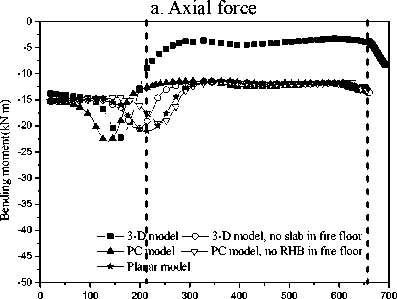
Temperature of heated top chord(oC)
b. Bending moment
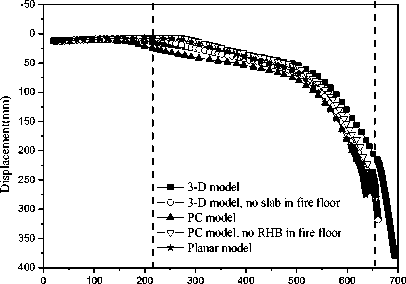
Temperature of heated top chord(oC)
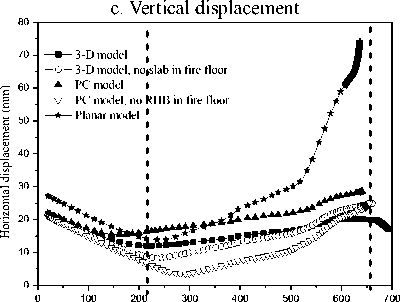
Temperature of heated top chord(oC) d. Horizontal displacement
Figure 11. Development of mechanical performances for the mid-span cross-section of top chord exposed to fire
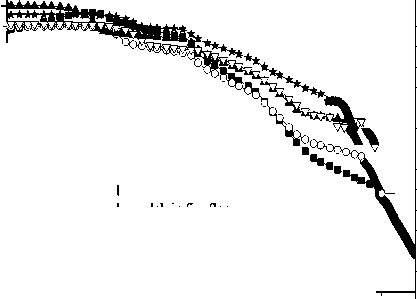
Time(s)
3-D model
3-D model, no slab in fire floor
PC model
PC model, no RHB in fire floor
Planar model
Figure 12. Axial force of vertical web members at the fifth panel (V4) of the truss exposed to fire
-200
-300
-400
-500
-600
-700
-800
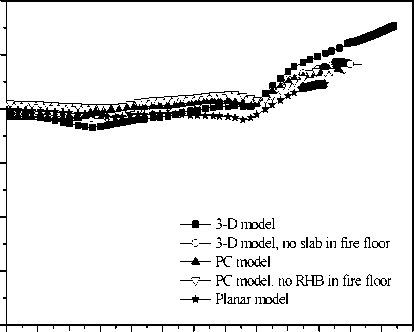
0 100 200 300 400 500 600 700 800 900 1000 1100 1200 1300
Time(s)
Figure 13. Axial force of vertical web members at the fifth panel (D4) of the truss exposed to fire
of the chord increases, and at the same time the lateral displacement of the truss decreases. The diagonal members in both side panels, that is, D1 and D4, also yield locally. With plastic deformation region expanding in web members, the restraint of web members is weakened. In this stage, the bending moment of the top chord keep consistent.
The third stage (III): The temperature of top chord in this stage is above 650oC. When the vertical displacement becomes large enough, the shortening in the chord length overtakes the chord’s thermal expansion. And the axial force of the top chord recedes to the value under the ambient temperature. The enhancing displacement induced by the degradation of the steel stiffness and yield stress counteracts the effects induced by the steel thermal expansion at the high temperature. In this phase, the deflection of chord increases rapidly until failure.
As can be seen in Fig.11, the development of the axial force, bending moment and displacement at the mid-span of the top chord exposed to fire and the lateral displacement of left end of top chord exposed to fire in different models all perform the above three stages. And all the mechanical performances in each case have a similar trend is similar in general, though there are some slight differences on the temperature when the variations appear.
As shown in Fig.11 (a), the axial force of top chord exposed to fire in the PC model with RHB in fire floor is the largest of all. It is due to the constraint of RHB at both sides of the truss during the thermal expansion. The axial forces obtained by PC model B and planar model are relatively small. And the axial force reaches the maximum when the temperature of top chord is above 250oC. The axial force of top chord in 3-D model is between the value of PC model and planar model.
In different models, the bending moments of top chord appear the same trend. It can be seen in Fig.11 (b), the 3D model considering the failure of slabs has a prominently similar trend on the development of bending moment with the PC models and planar model.
TABLE Ш .
Comparison of fire performance under different study cases
|
Case |
Failure time ( s ) |
Limited temperature ( oC ) |
Lateral displacement ( mm ) |
Calculation time ( h ) |
Storage space ( GB ) |
|
1 |
1240 |
690 |
45.6 |
51 |
180 |
|
2 |
1100 |
660 |
42.9 |
30 |
98.1 |
|
3 |
1032 |
640 |
42.8 |
4.75 |
9.1 |
|
4 |
1080 |
655 |
44.1 |
4 |
9.7 |
|
5 |
1019 |
636 |
114.3 |
2.5 |
7 |
As shown in Fig.11 (c), the developments of vertical displacements of top chord exposed to fire in different models are similar during the whole process of enhancement of temperature. And the trend of truss is similar in general. But in the planar model, the lateral displacement increase rapidly when the structural deformation enters to the stage II as a result of the neglect of the restraint effect of the adjacent frame.
Fig.12 and Fig.13 depict the axial force versus time of vertical and diagonal web members in the fifth panel of the truss exposed to fire respectively. It can be seen that the trend of the axial force of the web members in each case is similar in general. In initial stage of fire, there is slim difference among the axial force of diagonal web member in different models. With the enhancement of temperature, the axial forces of diagonal web members in PC models and planar model vary slowly, and the values become larger than those of others. In addition, the axial force values of vertical web member obtained by different models are close to each other during the fire process.
Comparisons on the calculated fire performance of SSTS under lateral force using different models are given in Tab.3. All of the cases are calculated by a computer with a CPU of AMD Phonom II X4 925 and 3GB memory, using ANSYS9.0 under the environment of Microsoft Windows XP. As can be seen, in 3-D Model A, the failure time of the structure due to the standard fire is 1240s with a limited temperature of 690oC. And in the 3D Model B, the failure time of SSTS is 1100s with a limited temperature of 660oC when the failure of slabs on the storey exposed to fire is considered. The fire resistant property reduces a little. The fire resistance and limited temperature obtained by the analysis of PC models and planar model is conservative, but the difference is still acceptable. The lateral displacement at top floor of SSTS based on the analysis of PC models is in the proximity of 3-D models, while the value obtained by planar model has a dramatic deviation because it ignores the effect of adjacent truss. As can be seen, the fire resistance, limited temperature and lateral displacement at top floor based on the analysis of PC model without RHB at fire floor are most approximate to 3-D model.
As a matter of fact, the result of the analysis of 3-D models is the best in accord with actual situation. But this method is time consuming and need lots of computer resource. For 3-D model A, 51h and 180GB storage space of the hard disk are required for the calculation. And it spends 30h to calculate the 3-D model B in this paper which consider the failure of slabs in fire floor. Fortunately, using the PC models and planar model to simulate could save lots of time and storage space. Only 4h and 9.7 GB space of hard disk are required for the calculation of PC model without RHB in fire floor. This method could get the result with considerable accuracy and save lots of time and computer resource. As a result, the PC model without RHB on the fire floor could be recommended to analyze the fire response behaviors of SSTS under lateral force in view of convenience.
И. Summaries and conclusions
-
(1) The adjacent trusses in steel staggered truss system under lateral force could keep good coordination at elevated temperature. At the floor not exposed to fire, the relative displacement of the adjacent trusses is slight. And great influence of high temperature can be induced on the truss exposed to fire, but the effect on the adjacent truss is unobvious. Hence, PC model and planar model can be used to the high temperature response analysis on SSTS under lateral force.
-
(2) The constraint of slab can make a certain extent effect on the axial force, bending moment, vertical deformation and lateral deformation of SSTS under lateral force and high temperature. The slabs of the floor exposed to fire may be destroyed by high temperature, so the transmission of force of the slab at this floor can be ignored to simplify the structural model. But the effect of slab at other floors should be considered in the analysis.
-
(3) In 3-D model, the interactions among the adjacent frame trusses and the effect of slabs can be considered in the fire resistance analysis of SSTS under lateral temperature. The result is the best in accord with actual situation. But this method is complicated and timeconsuming..
-
(4) The planar model is convenient. The calculation is time-saving, and it only needs small hard disk storage space. However, because of the neglect of the effect of adjacent trusses, it may lead to some observable deviation. The lateral displacement of planar model under high temperature is relatively large, which may cause great gravity second-order effect (gravity P-Δ effect) to the
SSTS. And it is possible to lead a great error to the results comparing to the actual situation in the instability analysis. As a simple and convenient choice, the model could be adopted for the simple evaluation for structures.
-
(5) The PC model, to some degree, can simulate the interactions between adjacent frame truss and the truss under fire effectively in the SSTS under lateral force. The result is conservative so it is beneficial to ensure the safety of structure. The time and space cost by PC model approximate to planar model, but the result is in the propinquity of 3-D model and has an acceptable accuracy. Because the calculation of 3-D model need lots of computer resource and may be time-consuming, the PC model without RHB on the fire floor is recommended to analyze the fire response behaviors of staggered-steel truss system under lateral force in view of convenience.
Acknowledgment
The study is financially supported by National Natural Science Foundation of China (Grant No. 50706059), and the open fund (Grant No. HZ2009-KF05) of State Key Laboratory of Fire Science of University of Science and Technology in China. The authors deeply appreciate the supports.
Список литературы Simplified Model for Fire Resistance Analysis on Steel Staggered-truss System under Lateral Force
- B. Aine, “Staggered truss system proves economical for hotels,” Modern Steel Construction, vol. 40, pp. 32, September 2000.
- L. Matthys p, “Staggered truss system earns an A+”. Modern Steel Construction, vol.40, pp. 28, November 2000
- XH Zhou, T Mo, YJ Liu, ZM Yin, LF Lu and QS Zhou, “Experimental study on high-rise staggered truss steel structure,” Journal of Building Structures, vol. 27, pp. 86-92, 2006
- XH Zhou, YJ He, L Xu and QS Zhou, “Experimental study and numerical analyses on seismic behaviors of staggeredtruss system under low cyclic loading,” Thin-Walled Structures, vol. 47, pp. 1343–1353, November 2009,
- J. Kim, J. H. Lee, Y.M. Kim, “Inelastic behavior of staggered truss systems”, Structural Design of Tall and Special Buildings, vol.16, 2007, pp. 85-105.
- http://www.aisc.org/Content/ContentGroups/Documents/Staybridge/Staybridge.htm, 2008.
- SK Choi, I Burgess and R Plank, “Performance in fire of long-span composite truss systems,” Engineering Structures, vol.30, pp. 683-694, March 2008.
- SK Choi, IW Burgess and RJ Plank, “Behaviour of lightweight composite trusses in fire – a case study,” Steel and Composite Structures, 2007, vol.7, pp.105-18.
- J Chang, AH Buchanan, PJ Moss. “Effect of insulation on the fire behaviour of steel floor trusses,” Fire and Materials, 2005, vol. 29, pp.181–94.
- NIST NCSTAR 1, “Final report on the collapse of the world trade center towers,” National Institute of Standards and Technology, 2005.
- G Flint, AS Usmani, S Lamont, J Torero and Lane B, “Effect of fire on composite long span truss floor systems,” Journal of Constructional Steel Research, vol.62, pp.303-315, 2006.
- AISC, “Steel Design Guide 14: Staggered Truss Framing System,” American Institute of Steel Construction: Chicago, 2002.
- CK Chen and Y Yang, “Numerical studies on the behaviors of staggered-steel truss system under fire conditions,” Progress in Safety Science and Technology, Changsha, vol. AⅣ, 2006, pp.690-694.
- CK Chen, R Xiao and D Zhang, “3-D Finite Element Analysis of the Response Behaviors of Steel Staggered-Truss Framing System at Local Elevated Temperatures,” Progress in Safety Science and Technology, Beijing, vol.7, pp. 769-773, 2008.
- Eurocode 3: Design of Steel Structures, Part 1.2: General Rules, Structural Fire Design. British Standards Institution, 2000.
- R. P. Gupta, S. C. Goel, “Dynamic analysis of the staggered truss framing system”, Journal of Structure Division, ASCE, vol. 7, 1972, pp. 1475-1492
- YC Wang, “Steel and Composite Structures: Behaviour and design for fire safety,” London: Spon Press, 2002.
- AH Buchanan, “Structural design for fire safety,” New York: John Wiley&Sons Ltd, 2001.
- A Santiago, LS da Silva, PV Real and M Veljkovic, “Numerical study of a steel sub-frame in fire,” Computers and Structures, vol. 86, pp.1619–1632, August 2008.
- Y.Z. Yin and Y.C. Wang, “A Numerical study of large deflection behaviour of restrained steel beams at elevated temperatures,” Journal of Constructional Steel Research, vol. 60, pp. 1029-1047, July 2004.

